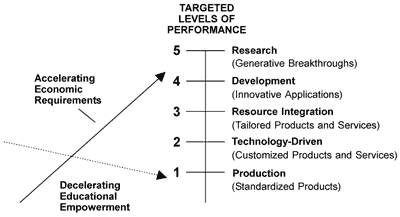Crossing Curves:
1. Crossing Curves
What is wrong with the following two pictures? Zhu Minh, general manager of the state-owned Bank of China, suggested the following:
The U.S. needs to reposition itself. Manufacturing is gone; services are going. Research and development is still there. The U.S. needs to move up the development chain.
On the other hand, Margaret Spelling, the administration’s Secretary of Education, wants “No Child Left Behind†legislation renewed intact.
I am deeply troubled that the draft would decrease information and options for students and parents—a key bright-line principle of NCLB.
Here is what is wrong with these pictures!
- Zhu Minh is right!
- Spelling is wrong!
What we have here, ladies and gentlemen, is a failure to think!
The current administration’s inability to think has produced the “crossing curves†of dysfunctional policy (see Figure 1).

Figure 1. Crossing Curves of Dysfunctional Policy
The first curve represents accelerating economic requirements on the way up to Research and Development. The second curve represents decelerating educational performance on the way down to standardize production. As may be noted, these curves cross on the way to our performance targets.
What this means is that we have fewer resources to do more demanding performances. This is a formula for disaster.
We will understand this formula better when we have been introduced to its ingredients.

December 4th, 2007 at 11:26 pm
Dear Bob,
I am convinced that the administration’s continued backing of NCLB is an effort to minimize the great potential that still exists in the school systems of the US today. By narrowly defining achievement and academic success into scores on multiple choice tests, the true potential of student thought will never challenge those in decision-making positions that want no challenges to the status quo. The incredible and consistent misuse of terms such as research-based, data driven decision making, best practices, has muddied the waters to the point that there is little substantive discussion between educators, and therefore no way to make constructive changes to educational policies and strategies.